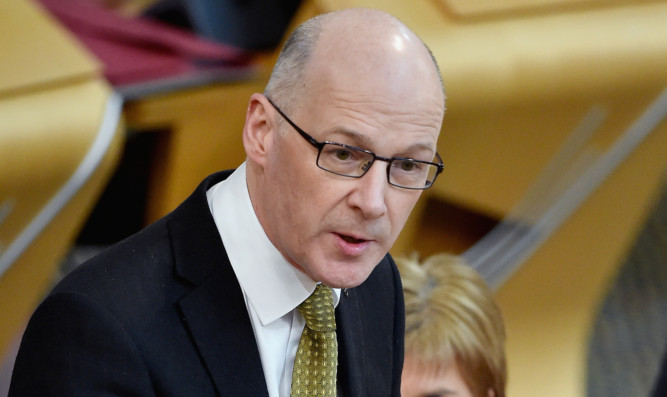Proposals to increase income tax in Scotland by 1p above the rate of the rest of the UK have been rejected at Holyrood.
The Scottish Government said the measure – put forward by Scottish Labour and supported by the Liberal Democrats – would “punish” low-paid workers.
Instead, the SNP administration used its parliamentary majority to back a freeze on income tax for 2016/17 by passing Finance Secretary John Swinney’s budget at its first stage.
Labour and the Lib Dems say it is necessary to use new tax powers due to come into effect from April 6 to provide almost £500 million of additional funding for education.
Schools will be hit by cuts to local authority budgets, they say, with council group Cosla complaining they are facing £350 million of cuts.
But Mr Swinney said the tax increase would hit the lowest-paid – including many local government workers – as he slammed Labour’s proposals to balance the rise with a £100 rebate for low earners as “back-of-the-fag-packet” policy.
https://youtube.com/watch?v=oxzoUexHhck%3Frel%3D0
“This government will freeze income tax and we will deliver a pay rise to around 50,000 of the lowest-paid workers in Scotland,” he said.
“The uprating of the living wage, its extension to social-care workers and an uplift of £400 for those covered by public-sector pay policy earning £22,000 or less will see tens of thousands better off because of this budget.
“That’s the difference between the SNP and Labour – we want to give the lowest-paid a pay rise, Labour want to give them a tax rise.”
On Labour’s rebate proposal, he said: “The immediate conclusion to draw from the rebate proposal is the recognition that this tax rise is damaging to the incomes of low-paid workers.”
Councils have until February 9 to sign up to a financial package which includes a continuation of the council-tax freeze, investment in integrating health and and social care and a commitment to maintain the pupil-to-teacher ratio in schools.
Members of the Unite and GMB Scotland unions gathered outside the Scottish Parliament to protest against the settlement ahead of the budget debate.
Labour’s Jackie Baillie said: “Make no mistake, the big losers in John Swinney’s budget are local communities, local schools and the local public services that people value.
“The budget cut to local government is hundreds of millions of pounds.”
Responding to criticism of the party’s proposed £100 rebate for lower-income taxpayers, she said: “Leaders in councils across Scotland who already make payments have made clear they are ready, willing and able to do this, so stop pretending it is too difficult.”
Scottish Liberal Democrat leader Willie Rennie said: “With his (Mr Swinney’s) refusal to use the powers of the Parliament he is imposing the kind of budget that he has previously condemned.
“The people of Scotland will know that his refusal to act means that every single cut to public services in Scotland is a John Swinney cut.”
Scottish Tory finance spokesman Murdo Fraser said: “We on these Conservative benches are happy to stand shoulder to shoulder with the SNP and hold the line against the tax-grabbers on the Labour benches and the Liberal Democrat benches, who would clobber Scottish families.”
Scottish Green co-convener Patrick Harvie said: “Wealth inequalities are even starker in Scotland than income inequalities. Wealth must become a bigger part of the taxation picture, not a smaller one.”
